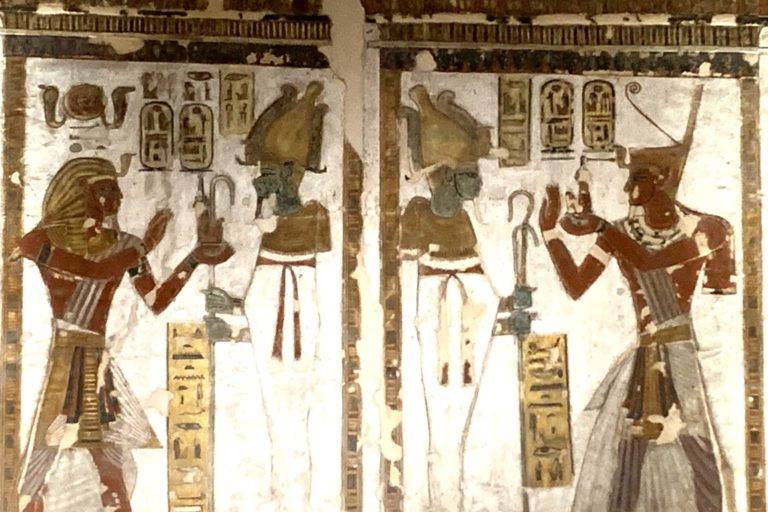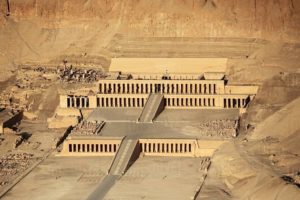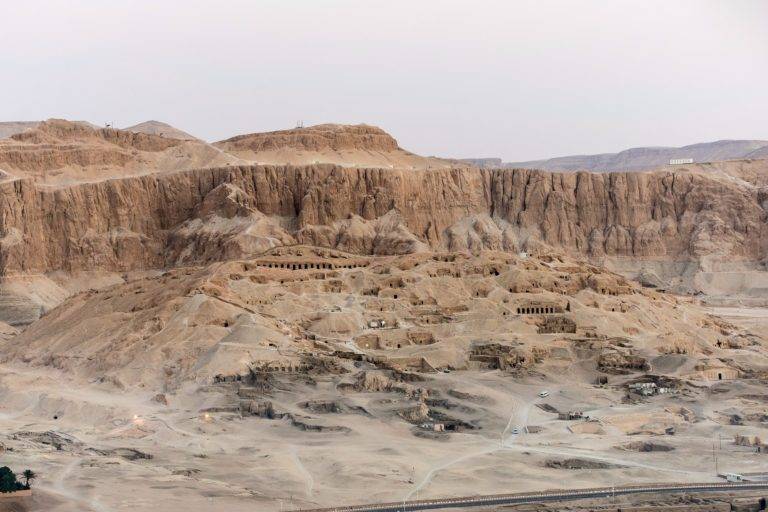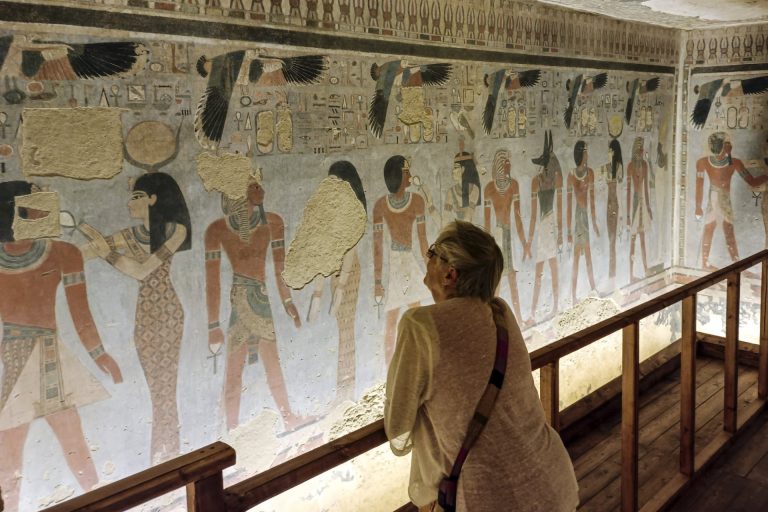Ramesseum
memorial temple of Ramesses II
On the West Bank of Luxor, where the fertile Nile valley meets the desert cliffs, stands the Ramesseum. This is the mortuary temple of Ramses II. The Ramesseum has long attracted travelers. Its fallen statues and worn reliefs inspired the poet Percy Bysshe Shelley to write the poem Ozymandias, which reflects on how power fades over time. Walking among the ruins today allows visitors to feel the ongoing presence of Ramses the Great, whose idea of eternal glory still resonates more than 3,000 years later.
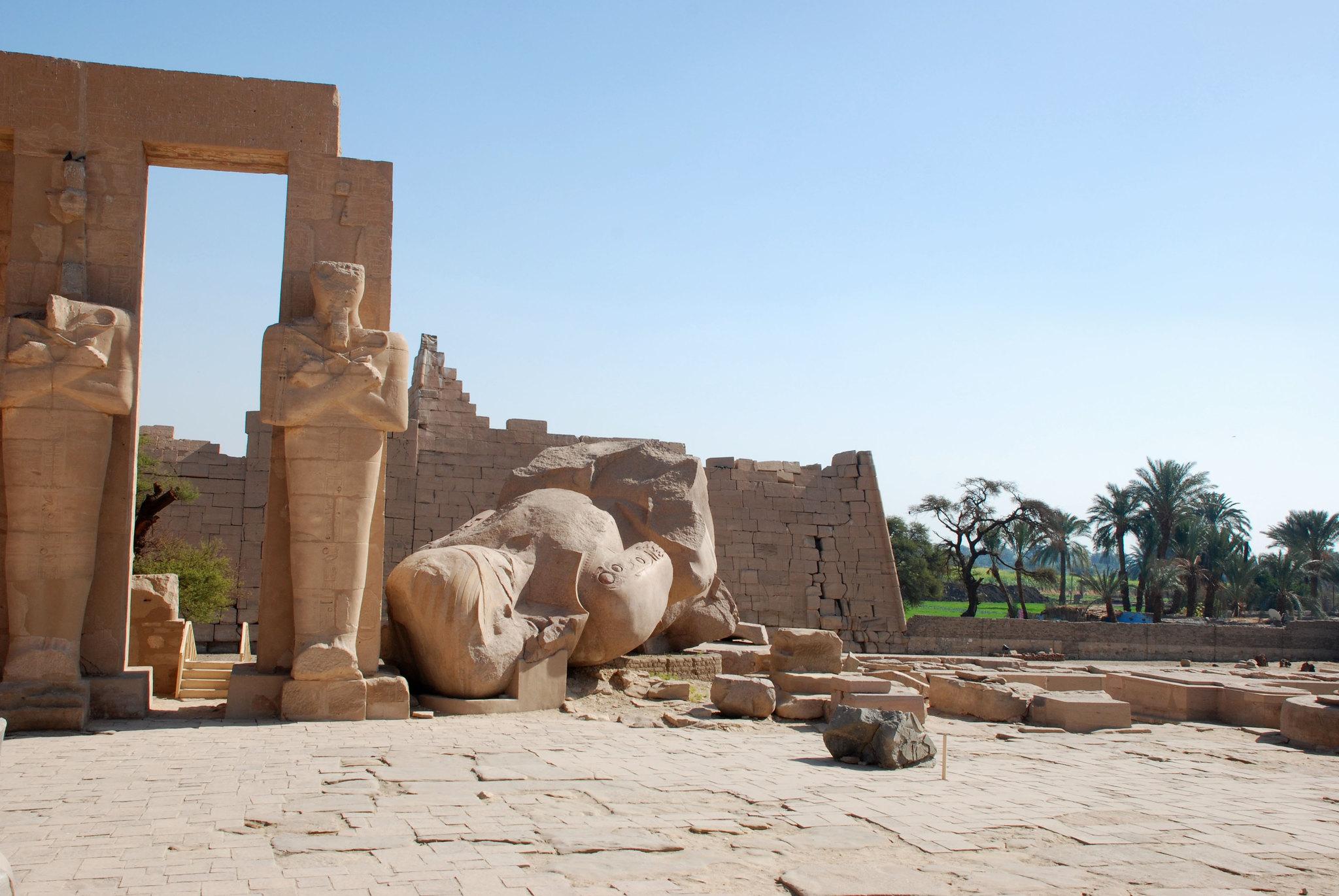
Ramses II: The Pharaoh Behind the Monument
Ramses II, also known as Ramses the Great, ruled ancient Egypt from 1279 to 1213 BCE. He was one of the most famous pharaohs and reigned for 66 years during the 19th Dynasty. His time as ruler included military campaigns, large building projects, and a strong image of being a god.
Military Achievements: Ramses II is best known for the Battle of Kadesh, which he fought against the Hittites. This battle is one of the earliest in history with detailed records. Although the results were mostly equal, Ramses claimed victory and had the story carved into temple walls throughout Egypt.
Builder of Monuments: Ramses II built many monuments, including the rock-cut temples of Abu Simbel and expansions at Karnak and Luxor. His temple, called the Ramesseum, was meant to glorify his reign and ensure people worshiped him forever.
Divine Legacy: Ramses II was treated as a god while he was still alive. His mortuary temple served as a religious site and a sign of his power as a god-king.
Luxor Tours & Activities
Looking to save some costs on your travel? Why not join a shared group tour to explore Luxor, Egypt? Here are some activities you might be interested in:
The Location of the Ramesseum
History and Purpose of the Ramesseum
The Ramesseum was built early in Ramses II’s reign as part of the tradition of mortuary temples. These temples served as places where people could honor the king after his death. Unlike tombs that were hidden away in the Valley of the Kings, mortuary temples were public spaces meant to show off the pharaoh’s achievements and provide offerings for his spirit.
Construction began in the 13th century BCE. The temple followed the typical design of the New Kingdom, featuring large entrances, open courtyards, columned halls, and sacred areas.
The Ramesseum was mainly dedicated to Amun-Ra, the main god of Thebes. It also honored Ramses II as a divine figure.
In comparison, while Hatshepsut’s temple at Deir el-Bahari focused on elegance and fitting in with the cliffs, the Ramesseum aimed to impress with its size and power.
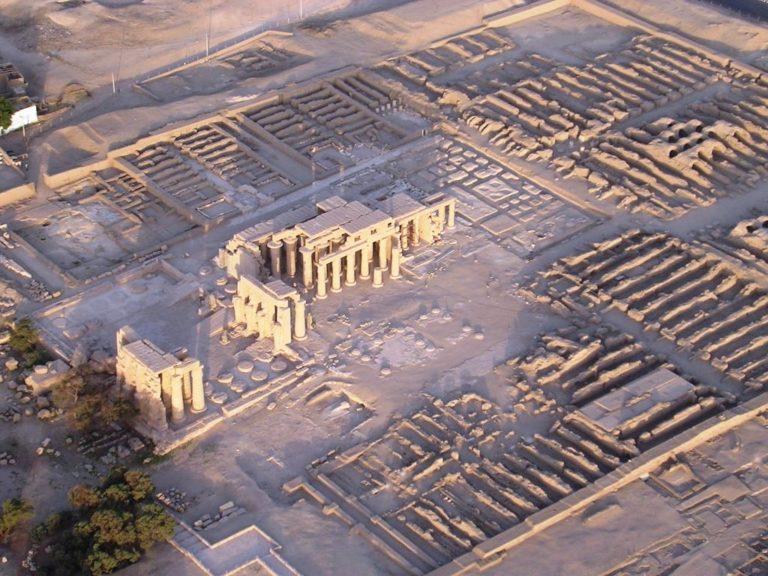
Architectural Highlights of the Ramesseum
Despite the damage from time, earthquakes, and looting, many parts of the Ramesseum still show its past grandeur.
The First Pylon: This was once a tall entrance that had carvings showing Ramses II’s claimed victory at Kadesh. These carvings served as propaganda, promoting him as Egypt’s protector.
The Fallen Colossus: The famous statue of Ramses II stood over 17 meters tall and weighed nearly 1,000 tons. Now, it lies in pieces, but its size still impresses visitors. Fragments of this statue were taken to the British Museum in the 19th century, sparking more interest in Ramses II in the West.
The Hypostyle Hall: This hall features 48 columns shaped like papyrus and lotus flowers. These columns are richly decorated with hymns to the gods and praises of Ramses II.
Sanctuary and Inner Chambers: These sacred rooms once held statues of the gods and the deified king, where rituals took place to ensure his eternal life.
Granaries and Storehouses: Archaeologists have found that the temple also served as an economic center, storing grain and supporting workers.
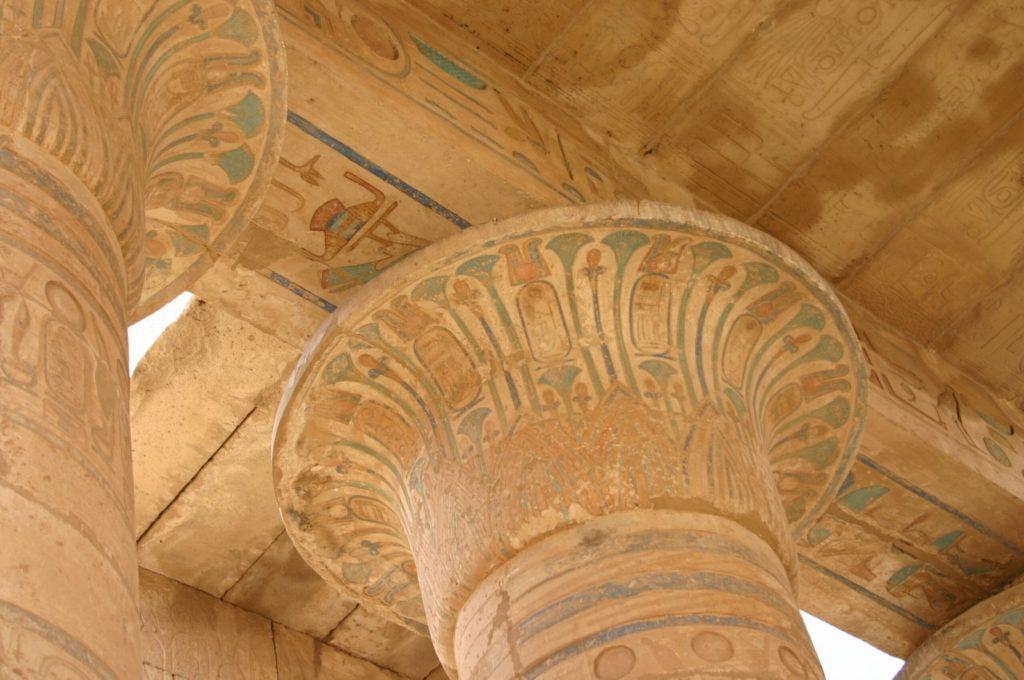
Symbolism and Artistry
The Ramesseum was built to show strength, divinity, and the idea of forever.
Ramses II is shown in reliefs, striking enemies or making offerings to gods. This imagery emphasizes his role as a warrior and priest.
The temple’s design connects to the Nile and uses symbols like papyrus and lotus, which represent creation and rebirth.
As a mortuary temple, the Ramesseum reflects the Egyptian belief in eternal life. It ensures Ramses II’s legacy will last “for millions of years.”
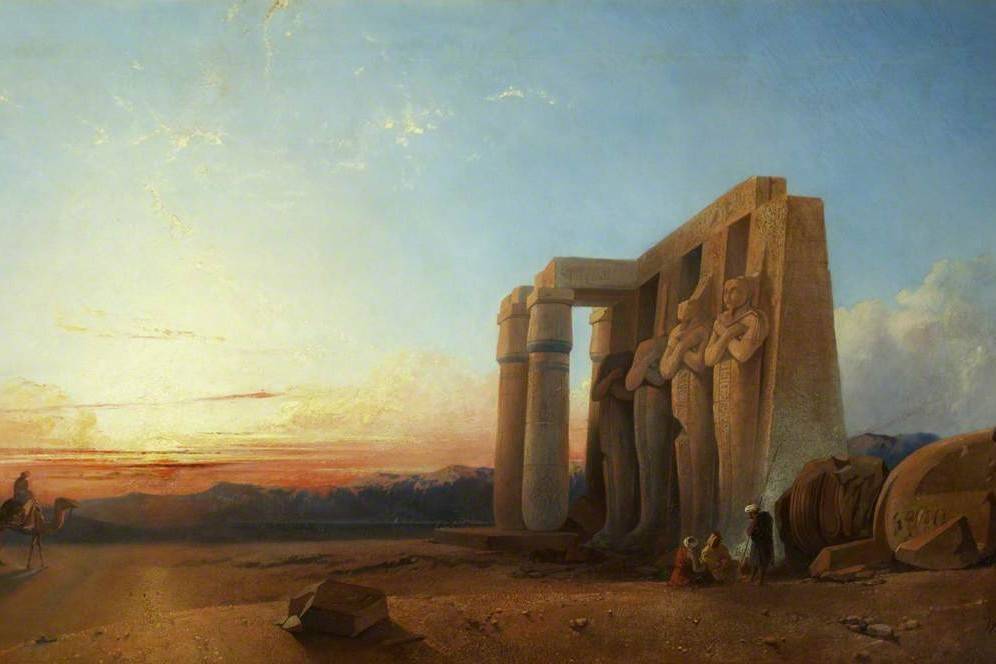
The Ramesseum in Literature and Culture
The temple is famous not just for archaeology but also in literature. In 1817, poet Percy Bysshe Shelley wrote the poem “Ozymandias” after hearing about the fallen statue of Ramses II. The poem includes the lines, “Look on my Works, ye Mighty, and despair!” which show the irony of great ambitions ending in ruins.
The Ramesseum has appeared in travel books, scholarly studies, and modern documentaries. It represents the greatness and vulnerability of civilizations. Its image symbolizes the rise and fall of empires, reminding us that even the strongest leaders cannot escape time.
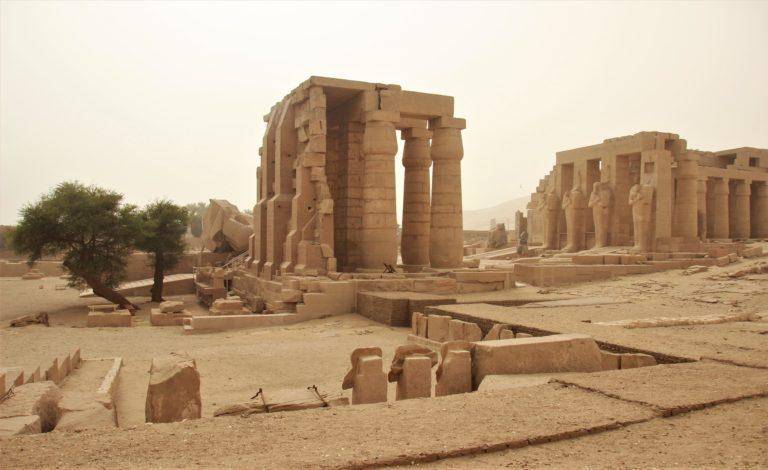
New Archaeological Discoveries at the Ramesseum
1. The House of Life (Per Ankh): Archaeologists found the remains of a school-like building. It included drawings, educational tools, and ancient games. This is the first time we have physical proof of a learning center at the Ramesseum, showing it was a place for education.
2. Workshops and Kitchens: The team also discovered workshops for weaving and stonework, along with bakeries and kitchens. This shows that the temple was a busy place for daily life and production.
3. Storage Facilities: They found large cellars filled with olive oil, honey, fats, and wine, along with many jar labels.
4. Administrative Offices: Buildings on the east side suggest there was a complex system managing the temple’s resources.
5. Later Tombs: The team uncovered many tombs from the Third Intermediate Period. These tombs contained coffins, canopic jars, ushabti figurines, and tools for funerals.
These findings show that the Ramesseum was not just a place for burial but also a lively institution—a center for worship, education, economy, and community.

Visiting the Ramesseum Today
- Location: West Bank of Luxor, near the Valley of the Kings and Medinet Habu.
- Tickets: Foreign Adult: EGP 220 – Foreign Student: EGP 110
- Opening Hours:
- Summer: 6:00 am – 5:00 pm
- Winter: 6:00 am – 4:00 pm
- Ramadan: 6:00 am – 4:00 pm
- Getting There: Hire a taxi, private driver, or join a guided tour. Many tours combine the Ramesseum with Deir el-Medina and Hatshepsut’s Temple.
- Travel Tips:
- Bring water and sun protection; shade is limited.
- Pair your visit with nearby Medinet Habu, one of the best-preserved mortuary temples.
- Allow at least 45 minutes to explore the site fully.
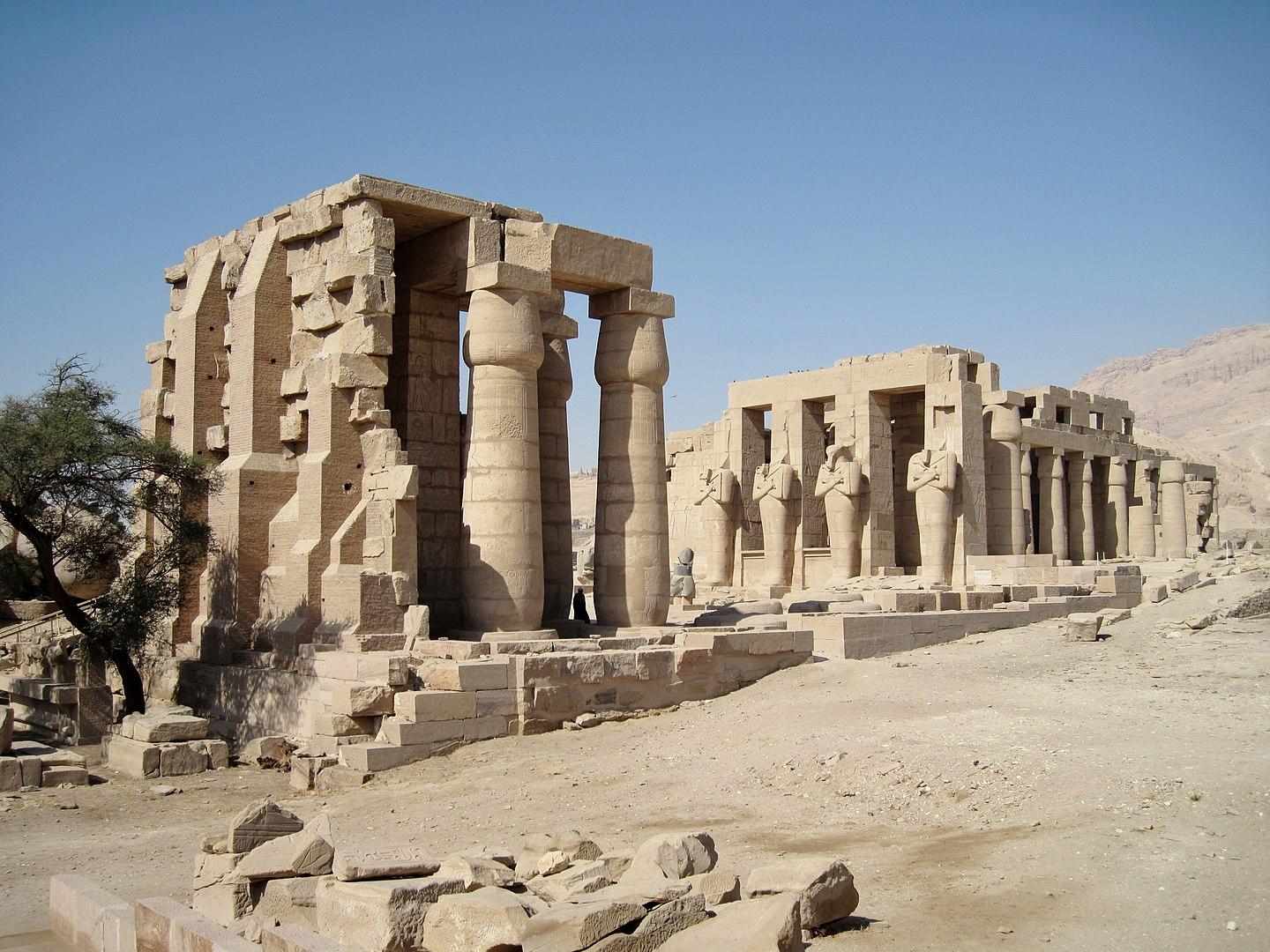
Why the Ramesseum Is Worth Your Time
Many visitors to Luxor focus on the Valley of the Kings or Karnak and often miss the Ramesseum. This temple has unique benefits:
Atmosphere: With fewer tourists, the site feels more personal, allowing you to take in its history.
Historical Depth: The reliefs and inscriptions show important details about Ramses II’s reign and ancient Egyptian beliefs.
Cultural Resonance: Standing in front of the fallen colossus can inspire the same awe that influenced Shelley’s famous poem.
Got a Question?
F.A.Qs
The Ramesseum is the mortuary temple of Pharaoh Ramses II, located on Luxor’s West Bank. Built in the 13th century BCE, it was designed as a “Million-Year Temple” to honor Ramses II in life and death, and to serve as a place of worship for the god Amun-Ra.
The Ramesseum is best known for its colossal fallen statue of Ramses II, once over 17 meters tall, and for inspiring Percy Bysshe Shelley’s poem Ozymandias. Its reliefs of the Battle of Kadesh and its grand hypostyle hall also make it a highlight of Luxor’s West Bank.
Highlights include the First Pylon with its battle reliefs, the toppled colossus of Ramses II, the hypostyle hall with lotus and papyrus columns, and the sanctuary. Archaeological finds also reveal workshops, granaries, and the remains of a “House of Life” (temple school).
The temple was constructed on a massive scale, with the main entrance alone measuring 67m by 183m.
Did you know that
By purchasing through our links, you support us at no additional cost.
Thank you for your support. ♥️

